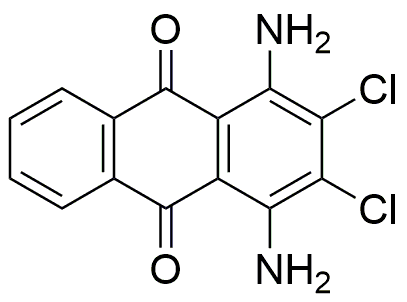1,4-Diamino-2,3-dichloroanthraquinone is widely utilized in research focused on:
- Dyes and Pigments: This compound is a key ingredient in the production of high-performance dyes, particularly for textiles and paper, offering vibrant colors and excellent lightfastness.
- Photovoltaics: It plays a significant role in organic solar cells, enhancing the efficiency of light absorption and energy conversion, which is crucial for sustainable energy solutions.
- Antimicrobial Agents: The compound exhibits antibacterial properties, making it valuable in developing coatings and treatments for medical devices and surfaces to reduce infection risks.
- Analytical Chemistry: Used as a reagent in various analytical techniques, it aids in detecting and quantifying specific compounds, benefiting laboratories in environmental and pharmaceutical analysis.
- Research in Material Science: Its unique properties are explored in the development of advanced materials, including sensors and electronic devices, due to its stability and conductivity.
General Information
Properties
Safety and Regulations
Applications
1,4-Diamino-2,3-dichloroanthraquinone is widely utilized in research focused on:
- Dyes and Pigments: This compound is a key ingredient in the production of high-performance dyes, particularly for textiles and paper, offering vibrant colors and excellent lightfastness.
- Photovoltaics: It plays a significant role in organic solar cells, enhancing the efficiency of light absorption and energy conversion, which is crucial for sustainable energy solutions.
- Antimicrobial Agents: The compound exhibits antibacterial properties, making it valuable in developing coatings and treatments for medical devices and surfaces to reduce infection risks.
- Analytical Chemistry: Used as a reagent in various analytical techniques, it aids in detecting and quantifying specific compounds, benefiting laboratories in environmental and pharmaceutical analysis.
- Research in Material Science: Its unique properties are explored in the development of advanced materials, including sensors and electronic devices, due to its stability and conductivity.
Documents
Safety Data Sheets (SDS)
The SDS provides comprehensive safety information on handling, storage, and disposal of the product.
Product Specification (PS)
The PS provides a comprehensive breakdown of the product’s properties, including chemical composition, physical state, purity, and storage requirements. It also details acceptable quality ranges and the product's intended applications.
Certificates of Analysis (COA)
Search for Certificates of Analysis (COA) by entering the products Lot Number. Lot and Batch Numbers can be found on a product’s label following the words ‘Lot’ or ‘Batch’.
*Catalog Number
*Lot Number
Certificates Of Origin (COO)
This COO confirms the country where the product was manufactured, and also details the materials and components used in it and whether it is derived from natural, synthetic, or other specific sources. This certificate may be required for customs, trade, and regulatory compliance.
*Catalog Number
*Lot Number
Safety Data Sheets (SDS)
The SDS provides comprehensive safety information on handling, storage, and disposal of the product.
DownloadProduct Specification (PS)
The PS provides a comprehensive breakdown of the product’s properties, including chemical composition, physical state, purity, and storage requirements. It also details acceptable quality ranges and the product's intended applications.
DownloadCertificates of Analysis (COA)
Search for Certificates of Analysis (COA) by entering the products Lot Number. Lot and Batch Numbers can be found on a product’s label following the words ‘Lot’ or ‘Batch’.
*Catalog Number
*Lot Number
Certificates Of Origin (COO)
This COO confirms the country where the product was manufactured, and also details the materials and components used in it and whether it is derived from natural, synthetic, or other specific sources. This certificate may be required for customs, trade, and regulatory compliance.


